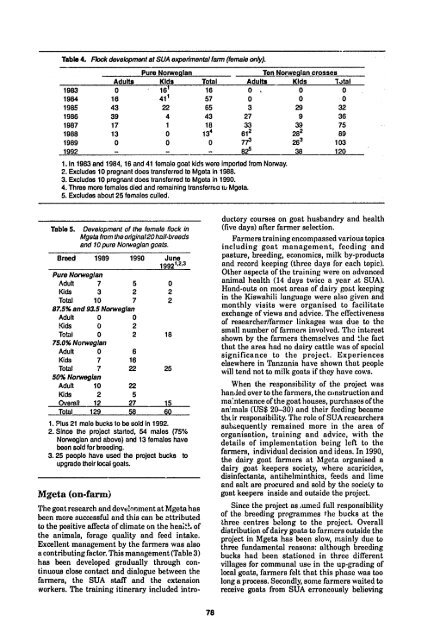aistand south~ern afrkca - (PDF, 101 mb) - USAID
aistand south~ern afrkca - (PDF, 101 mb) - USAID
aistand south~ern afrkca - (PDF, 101 mb) - USAID
Create successful ePaper yourself
Turn your PDF publications into a flip-book with our unique Google optimized e-Paper software.
Table 4. Rock development atSUA expeimental farm (female only).<br />
Pure Norwegian Ten Norwegian crosses<br />
Adults Kids Total Adults Kids *Tital<br />
1983 0 161 16 0 0 0<br />
1984 16 411 57 0 0 0<br />
1985 43 22 65 3 29 32<br />
1986 39 4 43 27 9 36<br />
1987 17 1 18 33 39 75<br />
1988 13 0 134 612 282 89<br />
1989 0 0 0 773 263 103<br />
1992 - - - 825 38 120<br />
1. In 1983 and 1984, 16 and 41 female goat kids were imported from Norway.<br />
2. Excludes 10 pregnant does transferred to Mgeta in 1988.<br />
3. Excludes 10 pregnant does transferred to Mgeta in 1990.<br />
4. Three more females died and remaining transferred tu Mgeta.<br />
5. Excludes about 25 females culled.<br />
Table 5. Development of the female flock In<br />
Mgeta from the oiginal20half-breeds<br />
and 10 pure Norwegiangoats.<br />
Breed 1989 1990 June<br />
19921.2.3<br />
Pure Norwegian<br />
Adult 7 5 0<br />
Kids 3 2<br />
Total 10 7<br />
87.5%and9.5 Norwegian<br />
2<br />
2<br />
Adult 0 0<br />
Aidul 0 0<br />
Kids 0 2<br />
Total 0 2 18<br />
75.0% Norwegian<br />
Adult 0 6<br />
KIds 7 16<br />
Total 7 22 25<br />
50% Norwegian<br />
Adult 10 22<br />
Kids 2 5<br />
Overall 12 27 15<br />
Total 129 5 60<br />
1. Plus 21 male bucks to be sold In 1992.<br />
2. Since the project started, 54 males (75%<br />
Norwegian and above) and 13 females have<br />
boon sold for breeding.<br />
3. 25 people have used the project bucks to<br />
upgrade their local goats.<br />
Mgeta (on-farm)<br />
The goat research and develonment at Mgeta has<br />
been more successful and this can be attributed<br />
to the positive affects of climate on the heait , of<br />
the animals, forage quality and feed intake.<br />
Excellent management by the farmers was also<br />
a contributing factor. This management (Table 3)<br />
has been developed gradually through continuous<br />
close contact and dialogue between the<br />
farmers, the SUA staff and the extension<br />
workers. The training itinerary included intro-<br />
78<br />
ductory courses on goat husbandry and health<br />
(five days) after farmer selection.<br />
Farmers training encompassed various topics<br />
including goat management, feeding and<br />
pasture, breeding, economics, milk by-products<br />
and record keeping (three days for each topic).<br />
Other aspects of the training were on advanced<br />
animal health (14 days twice a year At SUA).<br />
Hand-outs on most areas of dairy goat keeping<br />
in the Kiswahili language were also given and<br />
monthly visits were organised to facilitate<br />
exchange of views and advice. The effectiveness<br />
of researcher/farmer linkages was due to the<br />
small nu<strong>mb</strong>er of farmers involved. The interest<br />
shown by the farmers themselves and the fact<br />
that the area had no dairy cattle was of special<br />
significance to the project. Experiences<br />
elsewhere in Tanzania have shown that people<br />
will tend not to milk goats if they have cows.<br />
When the responsibility of the project was<br />
handed over to the farmers, the cnstruction and<br />
maintenance ofthe goat houses, purchases ofthe<br />
animals (US$ 20-30) and their feeding became<br />
tht ir responsibility. The role of SUA researchers<br />
subpequently remained more in the area of<br />
organisation, training and advice, with the<br />
details of implementation being left to the<br />
farmers, individual decision and ideas. In 1990,<br />
the dairy goat farmers at Mgeta organised a<br />
dairy goat keepers society, where acaricides,<br />
disinfectants, antihelminthics, feeds and lime<br />
and salt are procured and sold by the society to<br />
goat keepers inside and outside the project.<br />
Since the project asumed full responsibility<br />
of the breeding programmes the bucks at the<br />
three centres belong to the project. Overall<br />
distribution of dairy goats to farmers outside the<br />
dsrbto fdiygast amr usd h<br />
project in Mgeta has been slow, mainly due to<br />
three fundamental reasons: although breeding<br />
bucks had been stationed in three different<br />
villages for communal use in the up-grading of<br />
local goats, farmers felt that this phase was too<br />
long a process. Secondly, some farmers waited to<br />
receive goats from SUA erroneously believing

















